THIS ARTICLE: Will show you how to create a website for your expedition. One that efficiently promotes it before departure, can be managed easily from the field via mobile, satellite phone or internet cafe and which provides a permanent record after the event. It will demonstrate how to automatically integrate with Twitter and Facebook and also covers RSS Feeds, Flickr and newsletters. It is aimed at the enthusiastic amateur with no need for any web expertise and can be completed without spending any money.
[divide]
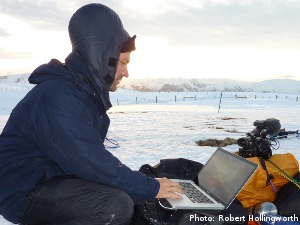
A common question I get asked by people preparing for an expedition is how I set up my blog and got it to link in with Facebook and Twitter.
I’ve found the combination of these three things (blog, Facebook and Twitter) an incredibly useful way of sharing my stories and, with a little bit guidance, it is very easily done.
This is a step-by-step guide to producing your own expedition website. You can either read it from start to finish or simply dive into the bits that are relevant to you.
[divide]
Why use a blog, Facebook or Twitter?
Some will argue that “Tweeting” from the field and updating your Facebook status in a tent detracts from the experience but this is not the place for that debate. I am assuming that by reading this you are interested in setting up an expedition website to share your story and that is what I intend to help with.
Expedition websites tend to serve three purposes:
- Promotion before departure (be it for fundraising, awareness, sponsorship commitments or purely the love of it)
- Providing updates from the field that people can follow from home
- Giving a lasting record of the expedition
Blogs do these things very well and Twitter and Facebook really help with the first two points. You don’t have to use all of these things and it may feel redundant to have them all but by combining them, you simply maximise your chances of reaching more people. And, as you will see below, it is not difficult to achieve.
I’ll show you how to automate everything so that you can make just one action (like updating your blog) and have it transported to all the other mediums. Allowing you to shout loudly about your expedition without making your throat hoarse.
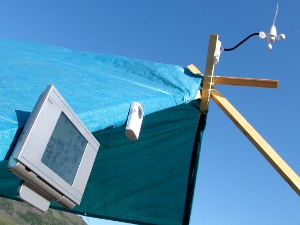
[divide]
Blogging #1 – Software
There are innumerable different ways to create a website – coding by hand, using specialist software, hiring a professional – but one of the most popular is to use online blogging software.
Online means that you don’t download any software, you just log onto a website so you can work from anywhere with an internet connection (useful if you’re not taking a laptop on your trip but will have occasional internet access at people’s houses or airports).
Blogging means that they’re designed for regular updates, like a diary. This often suits expeditions well (e.g. “Expedition Departs Tomorrow” or “Day 6 on the Amazon”) but even if it’s not what you’re after, I would still recommend these programs.
All of the following are free or have free options:
Blogger
Blogger, owned by Google, is incredibly simple and user friendly, and will get you a basic website in a matter of minutes. If you’re new to all of this and just want the easiest option then this is absolutely the one for you.
WordPress
This website is designed in WordPress. It’s more powerful than Blogger meaning it’s more flexible and you can add more features though that does mean it’s slightly more complicated to use.
- Examples: 2012 Inspire*, Walking the Amazon, Alastair Humphreys, Ben Saunders
- WordPress Website (download the software alone from WordPress.org)
*I built these websites
Alternatives
This article will focus on Blogger and WordPress as these are what I consider most appropriate (and have the most experience with) but some other options include:
- TypePad – Another popular piece of blogging software.
- Moonfruit – It’s not blogging software but does provide an idiot simple step-by-step guide.
- Joomla – For the more adventurous, this is a very powerful bit of software.
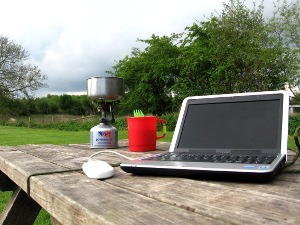
[divide]
Blogging #2 – Domain Name and Hosting
If you just want the quickest, easiest and cheapest way to a website then you can head straight to the Blogger or WordPress websites and skip this section.
But if you’d prefer to understand a little more and see your options then read on.
Domain
This is the address of your website (e.g. www.Greenland2011.com).
You can get these for free if you don’t mind having .blogspot or .wordpress in it (e.g.Greenland2011.blogspot.com). Buying one for a year will normally cost a few pounds. Less if it’s a .net, .info or similar (e.g. Greenland2011.info), more if it’s .com and popular (e.g. NorthPole2011.com).
I get my domain names from GoDaddy but just Google “domain name registration” and you’ll find many companies selling addresses.
Hosting
This is where the files for your website are actually stored. Again, if you use .blogspot or wordpress.com*, you don’t have to pay for this.
My websites are also hosted with GoDaddy for somewhere around £20-30 a year and a quick Google of “website hosting” will give you plenty of alternatives.
*If you’re considering free hosting with WordPress.com then you should read this article. You get a slightly different package as a result which is a bit simpler but has some restrictions.
[divide]
Blogging #3 – Updating by Phone/Email
The beauty of online blogging software is that you can update your website from anywhere with internet, like the pokey little internet cafe of the town your passing through on the way to the mountains.
But even if you only have a mobile, satellite phone or basic email access, or are in a country that’s blocked your website (as Iran did with mine for some reason) you can still update your blog. Here’s how:
- Mobile Phone – Send updates to Blogger by SMS (info here) or manage your WordPress site from a phone with various plugins (info here)
- Satellite Phone – This is most easily achieved by using your satellite phone to send an email then following the steps below. Most satphones have the ability to send SMS to email and you can often connect them to your laptop to achieve a similar result.
- Email – Whether from a mobile, satphone or regular email account, this is straightforward to set up. In Blogger, go to Settings -> Email and follow instructions for Mail-to-Blogger (info here). In WordPress, it’s Settings -> Writing then instructions under Post Via Email (info here).
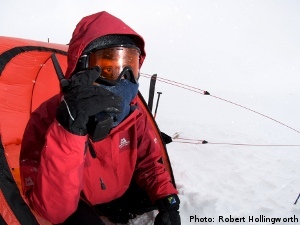
[divide]
What RSS is and why it’s important
RSS is a standardised format for the content of regularly updated websites (like a news page or blog). Your blog will convert its updates into what’s known as an ‘RSS Feed’. People can subscribe to your RSS Feed which means that they get updates delivered directly to them alongside any other webpages they read regularly using a bit of software called an ‘RSS Reader’ .
This might not seem relevant to you but don’t underestimate it’s usefulness for maximising your audience.
As an example, during North Pole season, there are always several teams on the ice who send daily updates. I subscribe to their RSS Feeds so I can do a quick check of how they’re getting on each morning. But, if they don’t have an RSS Feed, I can’t check it easily and therefore don’t bother, thus losing them one more follower.
WordPress and Blogger set up and RSS Feed automatically. All you need do is make it easy for people to find it. You may have noticed the icon at the top of every page on this site. If the link isn’t already obvious on your site then just add one yourself with either the word RSS (so lazy people, like me, can search for it) or with the orange RSS icon (below).

[divide]
Whatever you might think about Twitter, there is little doubt about its potential for use on expeditions. Updates delivered in seconds from the most remote of locations in a format that’s easy to integrate with other websites and easy for people to follow.
Using Twitter from a mobile, satphone or email
The beauty of Twitter for expeditioning is that you don’t need to have website access to update it. Registering your mobile phone to update via text message is easy (here) and works in many places across the world. I’ve “Tweeted” from my mobile whilst cycling through Arctic Norway and on the summit of a 3000-metre mountain in Siberia.
Alternatively, you can update via email on those occasions when you have email access but not internet (e.g. using a satphone through a laptop). If you register with Twittermail.com, you’ll get a unique email address to which you can send updates that will automatically appear on your profile.
Lastly, if you don’t think you’ll have mobile signal and will be taking a satellite phone then you can also use this in much the same way. Most satphone have SMS capabilities so you can try using the above method as if it were a normal cell phone.
If that doesn’t work, you can get around it easily with the method I set up for a South Pole Expedition last year. First, register with Twittermail.com (see above) then use the SMS-to-email feature of your satphone to send a message to the Twittermail account. (There’s a step-by-step guide here.)
Linking Twitter to your Blog
You can set up your blog to display your latest Twitter updates as I have done on the sidebar of this website. Twitter produces its own code for this (here) with a particularly easy interface for Blogger. Alternatively, there are a list of ways to integrate with Blogger here and for WordPress, I use the Twitter for WordPress plugin.
As well as having Twitter update your blog, you can work it the other way around so that every time you add something to your blog, it updates your Twitter account (e.g. “New Blog Post: Team arrives at Base Camp. Read more here…”). This is useful for the people who regular use Twitter but might not check your website and all contributes towards maximising your outreach. For this, use TwitterFeed.
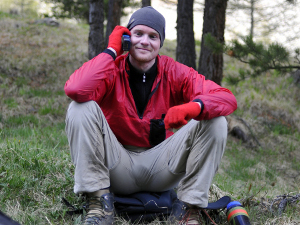
[divide]
You probably have lots of friends on Facebook and you’ll find that it’s very easy to communicate with them. That’s what it’s designed for. This is best achieved by setting up a Facebook Page or Group (see the difference here), or sending updates to your Facebook Profile.
Linking Facebook with your Blog
You can get your blog updates to appear automatically on Facebook. Plenty of Facebook users won’t bother to check your website every day but may well click a ‘Note’ that appears in their Facebook feed.
To send the updates to your profile, find the ‘Notes’ page on Facebook and click ‘Import Blog’ or ‘Edit Import Settings’ and follow the instructions. Step-by-step guide here if you need it.
To have updates appear on your Facebook Page, you can use the Blog RSS Feed Reader app.
(Note: If you set up your blog to automatically update your Twitter account and your Twitter account is feeding to your Facebook Profile/Page (see below), then even if you don’t connect your blog directly with Facebook, a link will at least be posted through this alternative route).
Linking Twitter to Facebook
You may want your Twitter updates to appear on your Facebook Profile, Page or Group. You could update Facebook directly (e.g. from your phone) but if you’re using both Facebook and Twitter then there’s no point duplicating your work.
You can do this on Facebook using the Twitter app.
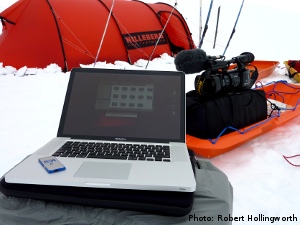
[divide]
Other Useful Tools
Flickr
This is a great way of storing, organising and sharing photos. And it can also integrate with your blog, Twitter and Facebook. So, for example, you can take a photograph on your mobile whilst cycling through Central Asia and send it Flickr which in turn updates your blog and Facebook page and sends a link to Twitter. Here is some help for integrating with Twitter, Facebook and your blog. A basic account is free.
Share Buttons
If you’re particularly interested in spreading the word about your expedition then it pays to make it easy for people to share your content. Adding things like Twitter “Re-Tweet” and Facebook “Like” buttons (like the ones below) helps. There is a huge world of options for this but here are some options for WordPress and Blogger.
Newsletters
Some people may prefer to have updates emailed to them. That’s fine but you can avoid creating extra work for yourself but getting a plugin that does it automatically. Try WordPress’ Automatic Newsletter and Blogger’s Feedburner subscription.
[divide]
Still need help?
Lastly, if you’re struggling to set one up yourself, would prefer not to or would like some more advanced features then it’s worth noting that I can build an expedition website for you. See here for details.
What do you think? Please do add your thoughts below…